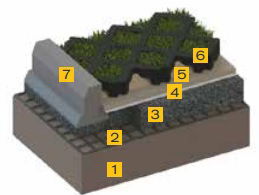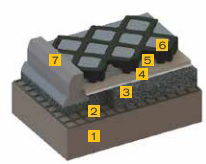
CellTrack Heavy Duty (HD) installation guideGrassed surfaces installation build up
Grassed surfaces installation instructionsThe following generic guidance must be read in conjuction with the specific project specification within the contract documents and the design notes below.
Gravel surfaces installation build up
Gravel surfaces installation instructionsThe following generic guidance must be read in conjunction with the specific project specification within the contract documents and the design notes below.
Design notesNote 1: If the optional geogrid is omitted, the total sub-base layer thickness (‘D’ on Table 1) is typically increased by a minimum of 50%. Selecting an alternative geogrid will require a redesign of the sub-base thickness. Note 2: Use of E'GRID 30/30 geogrid. If construction traffic axle loads will be greater than 60kN (approximately 6 tonnes), the minimum sub-base thickness over the geogrid shall be 150mm. Maximum sub-base particle size should match minimum subbase thickness but must not exceed 75mm diameter. For sub-base thicknesses of around 100mm, a minimum 37.5mm particle size should be adopted to allow effective installation of the geogrid. Note 3: Sub-base attenuation utilising a geomembrane and optional geotextile protection, is typically necessary to create a water storage facility and/or a groundwater protection function. Note 4: A permeable open-graded (reduced-fines) Sustainable Drainage System (SuDS) sub-base layer such as MoT Type 1x, Type 3 or Type 4/40, is preferred. However, where a conventional MoT Type 1 sub-base is to be installed, it is essential that a drainage system is incorporated to assist in the mitigation of issues associated with saturation. This drainage system would typically comprise of a network of perforated pipes or drainage geocomposite. Note 5: CBR% = California Bearing Ratio: an indicative measurement of subgrade soil strength. Specialist advice should be sought from a suitably qualified person for high-load or critical applications. Note 6: The SuDS permeable sub-base must be overlaid with a Multitrack 1000 geotextile to provide separation, enhanced water treatment function and prevent migration of the sand bedding layer. The sand bedding must be clean, coarse-grained sand free from silts & clays: it must not be soft building sand or silver sand. Note 7: The paver fill material should be good quality, free-draining friable topsoil suitable for grass growth and with no contaminants or oversized debris. Amenity grass seed mixture should contain hard-wearing, low fertility and/or drought-tolerant species with the option of a low percentage of clover content if acceptable. Note 8: The maximum advised gradient for vehicular trafficked applications is 8% (1:12) 5°. Note 9: When designed in accordance with the recommendations, CellTrack HD complies with BS8300:2009 : “Design of buildings and their approaches to meet the needs of disabled people” – Code of Practice (ISBN 9780 580 57419) & Building Regulations Document ‘M’ Sec. 6 Table 1
Typical sub-base thickness (D) requirements - refer to specific construction drawing Table 2
Field guidance for estimating sub-grade shear strengths Related products
| ||||||||||||||||||||||||||||||||||||||||||||||||||||||||||||||||||||||||||||||||||||||||||||||||||||||||||||||||||||||||||
